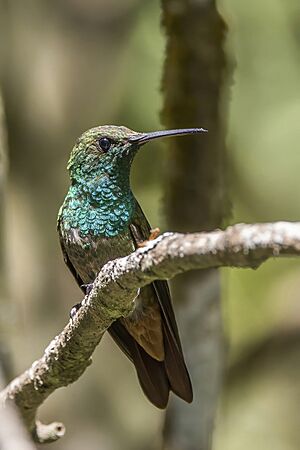Berylline hummingbird facts for kids
Quick facts for kids Berylline hummingbird |
|
|---|---|
 |
|
| Conservation status | |
| Scientific classification | |
| Genus: |
Saucerottia
|
| Species: |
beryllina
|
| Synonyms | |
|
Amazilia beryllina |
|
The Berylline hummingbird (Saucerottia beryllina) is a small, colorful bird. It's a type of hummingbird found in parts of Mexico, Guatemala, El Salvador, Honduras, and sometimes even the United States. These amazing birds are known for their bright feathers and how fast they can fly!
Contents
About Its Name
Scientists like to group animals based on how they are related. The Berylline hummingbird used to be in a group called Amazilia. But after looking closely at their DNA, scientists decided to move it to a new group called Saucerottia. This helps them understand bird families better.
There are five different types, or subspecies, of the Berylline hummingbird. They are a bit different depending on where they live:
- S. b. viola
- S. b. beryllina
- S. b. lichtensteini
- S. b. sumichrasti
- S. b. devillei
What It Looks Like
The Berylline hummingbird is about 8 to 10 cm (3.1 to 3.9 in) long. That's about the size of your finger! Males weigh around 4.4 g (0.16 oz), and females are a bit lighter at 4.0 g (0.14 oz).
Colors and Markings
Most Berylline hummingbirds have a shiny bronze-green or coppery head and back. Their tail feathers are often coppery or reddish-brown. When their wings are closed, you can see a chestnut-colored patch. Their bellies are a sparkling golden-green.
Differences Between Males and Females
Adult male Berylline hummingbirds have a black upper beak and a pinkish lower beak with a black tip. Females look very similar to males. However, their throat and belly might be a bit paler or more grayish. Their entire beak is usually black.
Young Birds and Subspecies
Young hummingbirds look like females but have a grayish-cinnamon belly. The different subspecies can have slight variations in color. For example, some might have a grayish back, a fawn-colored belly, or a violet tail. Others might be lighter green or have a purplish shine on their tail.
Where It Lives
The Berylline hummingbird lives in different areas depending on its subspecies:
- S. b. viola is found in western Mexico, sometimes reaching the southwestern US.
- S. b. beryllina lives in central Mexico.
- S. b. lichtensteini is in western Chiapas, southern Mexico.
- S. b. sumichrasti is in southeastern Oaxaca and northern Chiapas, southern Mexico.
- S. b. devillei is found in southern Guatemala, El Salvador, and central Honduras.
Its Favorite Places
These hummingbirds prefer dry areas. You can find them in many different places. This includes thick oak and pine forests, scrublands, and even gardens and parks. They usually live between 500 and 1,800 m (1,600 and 5,900 ft) above sea level.
How It Behaves
Moving Around
Berylline hummingbirds usually stay in one place for most of the year. However, those living in the far north of their range fly south for winter. They have also been seen more often in places like Arizona and New Mexico. Even in their main homes, they might move to different elevations during certain seasons.
What It Eats
The Berylline hummingbird eats nectar from many different kinds of flowers. It doesn't matter if the flowers are native or were brought in by people. They feed at all levels of the forest, from low bushes to tall trees. They often gather with other hummingbirds at flowering trees. They are quite strong and can often chase away other hummingbirds to protect their feeding spots. Besides nectar, they also eat small insects. They catch these insects by flying out from a perch or by picking them from spider webs.
Raising a Family
In some areas, like Oaxaca, Berylline hummingbirds breed between June and October. They build a strong cup-shaped nest using grass and other plant fibers. They hold it together with spiderwebs and decorate the outside with lichens. The nest is usually placed on a horizontal branch, sometimes as high as 15 m (50 ft) off the ground. The female bird lays two eggs and sits on them to keep them warm. The baby birds usually leave the nest about 20 days after hatching.
Its Sounds
The Berylline hummingbird has a varied song. It often sounds like high-pitched, slightly rough twittering notes. It might start with lisping sounds. Some people describe its song as "ssi kirr-i-rr kirr-i-rr" or "sirrr, ki-ti ki-dik." It also makes calls that sound like a hard, buzzing "dzzzzir" or "drrzzzt."
Its Conservation Status
The IUCN (International Union for Conservation of Nature) says the Berylline hummingbird is a species of "Least Concern." This means it's not currently in danger of disappearing. It lives across a large area and has a stable population of about two million adult birds. Scientists haven't found any immediate threats to this species. It is common in Mexico and further south, but it is very rare in the United States.


